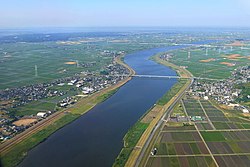Tone River
You can help expand this article with text translated from the corresponding article in Japanese. (October 2018) Click [show] for important translation instructions.
|
| Tone River | |
|---|---|
 | |
 | |
| Native name | 利根川 (Japanese) |
| Location | |
| Country | Japan |
| Physical characteristics | |
| Source | Mount Ōminakami |
| • location | Minakami, Gunma |
| • coordinates | 37°03′16″N 139°06′05″E / 37.05444°N 139.10139°E |
| • elevation | 1,831 m (6,007 ft) |
| Mouth | Pacific Ocean |
• location | Chōshi, Chiba |
• coordinates | 35°44′45″N 140°51′07″E / 35.74583°N 140.85194°E |
• elevation | 0 m (0 ft) |
| Length | 322 km (200 mi) |
| Basin size | 16,840 km2 (6,500 sq mi) |
| Discharge | |
| • average | 256 m3/s (9,000 cu ft/s) |
The Tone River (利根川, Tone-gawa) is a river in the
Geography
The source of the Tone River is at
Tributaries
Major tributaries of the Tone River include the
History
The Tone River was once known for its uncontrollable nature, and its route changed whenever floods occurred. It is hard to trace its ancient route, but it originally flowed into
Its vast watershed is thus largely artificial.Two ships of the
Fukushima Daiichi nuclear disaster
As a result of the
Use

The Tone River was an indispensable inland water link between the capitol at
Rafting and kayaking
The
Cycling
The Tone River is home to Japan's longest car free cycling path. At over 220km long the Tone River Cycling Road 利根川サイクリングロード starts in Shibukawa City, Gunma and runs all the way to Choshi City, Chiba. The total route is over 230km but the final 10km or so into Choshi is on a road. The remaining 220km is on detached cycling paths high up on the river bank with great views of mountains while in Gunma and large rice fields and agriculture as you approach the ocean. [8]
Image gallery
-
Tone River at Narita and Kawachi
-
Kurihashi Water Level Observatory (June 2005)
-
View of Tone River mouth and Chōshi city from air
References
- ^ a b "利根川の紹介" (in Japanese). Ministry of Land, Infrastructure, Transport and Tourism, Japan. Retrieved 2019-10-16.
- ^ a b "Tone River". Encyclopædia Britannica. Chicago, Ill.: Encyclopædia Britannica. 2012. Retrieved 2012-12-19.
- ^ "Edo-jidai no Tonegawa" (PDF) (in Japanese). Ministry of Land, Infrastructure, Transport and Tourism, Japan. Retrieved 2019-10-16.
- ^ "Tonegawa kindai kaishū no hajimari" (PDF) (in Japanese). Ministry of Land, Infrastructure, Transport and Tourism, Japan. Retrieved 2019-10-16.
- ^ "Crown Prince Naruhito, Dutch prince visit canal in Chiba Pref". AP. 14 September 2010. Archived from the original on 2014-03-21.
- ^ JAIF (26 April 2012)Earthquake Report 412: Cesium contaminated fish found in Tone river Archived 2012-05-22 at the Wayback Machine
- ^ Minakami Rafting
- ^ "The Tone River Cycling Road | Japan's Longest Car Free Bike Route". 18 October 2021.
External links
![]() Media related to Tone River at Wikimedia Commons
Media related to Tone River at Wikimedia Commons






